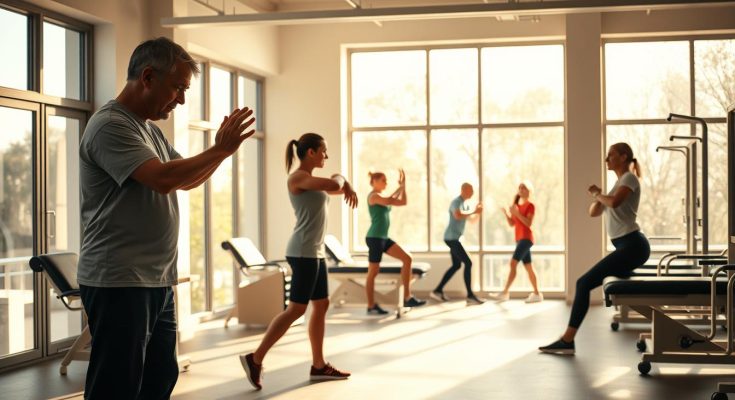Did you know that over 8.6 million sports-related injuries happen in the U.S. every year? Athletes face more than just healing. They need to regain strength, move well, and feel confident again. A clear rehab plan is key.
Key Takeaways
- Sports injury rehab follows four progressive stages for optimal recovery
- Early intervention reduces long-term damage and speeds healing
- Specialized care plans address individual athletic goals
- Jacksonville-based clinics offer tailored recovery strategies
- Professional guidance minimizes reinjury risks
Understanding Sports Injuries and Rehabilitation
Sports injuries can really upset an athlete’s plans. But, with the right help, getting better is possible. Whether you play sports a lot or just on weekends, knowing about injuries and how to get better is key to coming back strong.
Common Types of Sports Injuries
Two injuries are big topics in sports. ACL tears often keep basketball and soccer players out for months. Baseball pitchers and swimmers often get rotator cuff injuries because of the way they move their shoulders.
Winter sports athletes face their own challenges. Skiers, like Olympic medalist Valérie Grenier, show how important it is to have a plan for recovery. They deal with knee injuries from skiing. These examples show that injuries differ by sport but have similar ways to get better.
The Role of an Expert Rehabilitation Specialist
Sports injury recovery experts are very important. Top athletic therapy professionals do more than just fix injuries. They understand how athletes move and use:
Sport-specific recovery timelines
- Cross-training techniques to keep fit
- Precision progress tracking
At places like MOTION RX, experts use their knowledge from many sports to make recovery plans. A baseball pitcher might use swimming therapy for their shoulder. A skier might use basketball injury methods for their knee. This way, athletes can feel confident and strong again.
The best rehab specialists are like coaches, healers, and analysts all in one. They turn “I’ll never play again” into “When can I get back out there?” excitement. They do this with care and proven ways to get better.
The Importance of Rehabilitation in Sports
Rehabilitation is more than fixing injuries. It’s a science to keep athletes safe for years. Top sports rehab clinicians use new methods and care for each athlete. This way, athletes come back stronger and avoid future injuries.
Preventing Future Injuries
Reinjury rates can fall by up to 60% with the right rehab plan. MLB pitcher Reed Garrett is a great example. He worked with skilled sports injury specialists to avoid serious shoulder damage.
They used special technology to find and fix muscle imbalances. This approach fixes the problem, not just the symptoms.
“Biomechanical analysis lets us predict vulnerabilities before they become injuries. It’s like giving athletes armor for their comeback.”
— MOTION RX Lead Clinician
Here are some key ways to prevent injuries:
- Gait analysis to improve how you move
- Strength training for muscles that are weak
- Balance drills to keep joints stable
Enhancing Performance Post-Injury
Modern rehab doesn’t just fix injuries. It makes athletes better than before. Garrett’s fastball got 3.1 mph faster after rehab.
| Technique | Purpose | Outcome |
| Eccentric loading | Boost tendon resilience | 27% fewer strain injuries |
| Proprioceptive training | Enhance body awareness | 19% faster reaction times |
| Plyometric drills | Increase explosive power | 5% jump height improvement |
Working with expert sports rehabilitation specialists turns recovery into a chance to get better. Athletes often do even better than before their injury.
read more : Understanding Dew Point: The Hidden Force Behind Weather Comfort
The First Stage: Acute Injury Management
Quick care by experts is key for athletes to recover fast. This early stage aims to lessen damage, ease pain, and start the healing process. Places like MOTION RX have 24-hour injury response protocols, just like MLB pitchers get for shoulder injuries.
Initial Assessment by Specialists
Certified sports rehab pros do a full check-up soon after injury. At MOTION RX, they use digital swelling trackers to track swelling changes. These tools help spot serious injuries that need more tests.
R.I.C.E. Method for Immediate Care
The R.I.C.E. method is a top choice for quick injury care:
- Rest: Stop further harm by changing activities
- Ice: Use cold packs for 20 minutes to reduce swelling
- Compression: Wear wraps to help fluids move out
- Elevation: Keep injured areas up to lower blood flow
Today’s clinics add pneumatic sleeves to R.I.C.E. for better pressure control.
Importance of Early Intervention
Waiting 72 hours to treat can make recovery take longer, up to 40%. Justin Garza’s quick medical help shows the value of early professional assessment. Experts make plans that fix physical harm and prevent future problems.
The Second Stage: Restoration of Motion
After dealing with acute injuries, athletes start working on moving freely again. This stage is all about getting rid of scar tissue and making joints more flexible. Experienced sports injury therapists use special techniques to help athletes like Sonny Watson recover from tough shoulder injuries.
Techniques for Increasing Flexibility
Today’s rehab programs use dynamic stretching that fits each athlete’s needs. Therapists might use:
- PNF (Proprioceptive Neuromuscular Facilitation) stretching
- Active-assisted range of motion exercises
- Yoga-inspired stabilization sequences
Manual Therapy Approaches
Top clinics like MOTION RX mix NBA-approved soft tissue mobilization with myofascial release. Their therapists apply:
| Technique | Purpose | Recovery Benefit |
| Graston Method | Break adhesions | Improved tissue glide |
| Joint Mobilization | Restore joint play | Increased movement range |
| Trigger Point Therapy | Reduce muscle knots | Pain reduction |
Role of Stretching and Mobility Exercises
Custom mobility routines keep progress going between therapy sessions. A typical program includes:
- Foam rolling for myofascial release
- Dynamic warm-ups mimicking sport-specific movements
- Controlled eccentric loading exercises
Watson’s recovery shows how these methods, with expert help, can speed up getting back to functional mobility.
The Third Stage: Strengthening Phase
Getting back to top shape is key. Athletes first tackle pain and regain movement. Then, they work with elite sports rehab practitioners to build power for their sport. This step is all about getting ready for competition again.
Developing a Personalized Strength Program
At clinics like MOTION RX, experts make plans just for you. For hockey star Brian Wensink, they used:
- Force plate analysis to measure weight distribution
- Slow-motion video breakdowns of skating motions
- Position-specific resistance targets
These steps make sure exercises fit your sport. Plans change every week based on how you’re doing.
Key Exercises to Focus On
Good routines mix old and new moves:
| Exercise Type | Primary Benefit | Equipment Used |
| Eccentric Loading | Builds tendon resilience | Weighted sleds |
| Rotational Core Work | Enhances explosive power | Medicine balls |
| Single-Leg Stability | Improves balance | Balance boards |
Monitoring Progress With Experts
Rehab teams watch how you’re doing with:
- Biweekly strength tests
- Range-of-motion comparisons
- Pain response journals
“We adjust loads the moment an athlete exceeds baseline metrics,” says a MOTION RX expert. This way, you avoid getting stuck and stay on track.
The Fourth Stage: Functional Training
After rebuilding strength and mobility, athletes face their final challenge. They need to bridge the gap between rehab and real-world performance. This phase focuses on sport-specific movements and decision-making under pressure.
Transitioning Back Into Sports
Returning to play isn’t easy. Leading sports recovery specialists create gradual reintegration plans. For example, pitchers like Brandon Sproat followed tailored MLB return protocols.
- Controlled pitch count progression
- Biomechanical analysis during throws
- Daily recovery monitoring
Simulating Game Situations
Modern rehab centers like MOTION RX use advanced game-simulation labs. Their program for baseball players includes:
| Drill Type | Purpose | Success Metric |
| Cognitive Pitch Sequencing | Improve decision speed | 90% correct call rate |
| Pressure Scenarios | Build stress resilience | Consistent mechanics under fatigue |
| Multi-Directional Movement | Enhance field responsiveness | Sub-2.5 sec reaction time |
Psychological Readiness for Return
Many athletes report feeling 100% physically but hesitant mentally. Recovery specialists address this through:
- Visualization exercises
- Gradual exposure to crowd noise simulations
- Post-session confidence assessments
One MOTION RX therapist notes:
“We treat nerves like muscles – they need progressive training too.”
Importance of Individualized Rehabilitation Plans
No two athletes heal the same way. Just as every sport demands unique skills, every recovery journey needs a custom-built approach for success. Generic rehab programs often fail because they ignore important factors like body mechanics and personal goals. This is where expert sports rehabilitation specialists excel – they create plans as unique as fingerprints.
Tailoring Rehab to Specific Needs
A college volleyball player recovering from a shoulder injury needs a different plan than a marathon runner with knee pain. Specialists at clinics like MOTION RX in Jacksonville look at many factors:
- Type and severity of injury
- Sport-specific movement patterns
- Psychological readiness to return
Inspired by Dawn Staley’s coaching philosophy – “Success happens when preparation meets opportunity” – they use the latest techniques with personalized care. They even adjust hydration plans and sleep schedules to help heal faster.
Working With Multi-Disciplinary Teams
Great rehab isn’t a solo act. At MOTION RX’s Jacksonville clinic, athletes work with:
- Physical therapists restoring mobility
- Sports psychologists building mental resilience
- Nutritionists optimizing recovery diets
“Teamwork turns small wins into comebacks,” says a specialist, echoing Staley’s collaborative methods. This 360-degree support helps athletes rebuild strength while reducing re-injury risks.
By blending expertise across fields, expert sports rehabilitation specialists create plans that adapt as healing progresses. Whether you’re training for the Olympics or a weekend 5K, individualized care makes all the difference.
Continuing Care: Beyond Rehabilitation
Recovery doesn’t stop when athletes finish rehab. They need structured post-rehab strategies from certified sports pros. This phase helps them stay successful and avoid injuries.
Gradual Transition to Full Activity
Olympic skier Valérie Grenier’s comeback shows the power of slow steps back. Her team at MOTION RX used a 6-month monitoring program. They used tech and video calls to:
- Watch muscle activity during training
- Change workout intensity based on data
- Spot fatigue before it causes problems
| Phase | Duration | Key Tools |
| Reintegration | Weeks 1-4 | GPS trackers, heart rate monitors |
| Intensity Building | Weeks 5-8 | EMG sensors, motion capture |
| Sport-Specific Drills | Weeks 9-24 | Video analysis, force plates |
Importance of Follow-Up Appointments
Certified sports pros say 3 key things matter in post-rehab care:
- Check biomechanics every 45 days
- Update nutrition plans based on activity
- Check mental readiness
Grenier’s team had monthly face-to-face meetings and weekly video calls. This mix helped spot small issues before they became big problems. “The real work starts after medical clearance,” says her lead therapist. “That’s when we build competitive confidence.”
Resources for Finding Expert Sports Rehabilitation Specialists
Finding a skilled sports injury therapist is key. The right one helps you recover and succeed in sports. Here are steps to find top-notch professionals.
Key Qualifications to Look For
When looking for a specialist, check their credentials. Compare them to the Glengarry Hall of Fame selection criteria. This criteria highlights:
| Criteria | Glengarry Standard | Specialist Qualification |
| Experience | 10+ years in elite sports | Proven work with athletes in your sport |
| Education | Advanced certifications | Licenses in sports medicine or physical therapy |
| Peer Recognition | Awards or leadership roles | Positive reviews from athletes |
MOTION RX has experienced sports injury therapists certified by the American Board of Physical Therapy Specialties. They offer a free 20-minute consultation to check your needs.
“The best rehab plans blend science with personalized care – always ask how a specialist tailors their approach.”
Questions to Ask Potential Specialists
Ask these questions to check their expertise:
- How do you stay updated on the latest rehab techniques?
- Can you share success stories from athletes with similar injuries?
- Do you collaborate with coaches or trainers during recovery?
Clinics like MOTION RX are open about their methods. They give clear answers on treatment plans and timelines. Their specialists say things like, “We adjust exercises weekly based on progress scans,” showing they adapt to your needs.
MOTION RX is at 7901 Baymeadows Way #5. They mix new techniques with care that fits each athlete. Their rehab starts with treating the injury and ends with training for sports. Each step builds on the last, aiming for athletes to perform at their best again.
Conclusion: The Path to Recovery and Prevention
Getting better from sports injuries takes more than just hard work. It needs a team effort between athletes and top sports rehab experts. At MOTION RX’s Jacksonville clinic, they focus on care that fits each athlete. This way, athletes get stronger and avoid getting hurt again.
Basketball star A’ja Wilson says her rehab plan and safety steps helped her stay at the top. This shows that a well-planned recovery plan really works.
Patience Builds Lasting Results
Trying to rush recovery can lead to more problems. A slow and careful plan helps tissues heal and muscles get strong again. This careful work in each step is key to lasting success in sports.
Trusting Expertise Makes the Difference
Getting help from pros speeds up healing. Places like MOTION RX use the latest methods and teamwork. They help with both body and mind.
Alpine skier Valérie Grenier came back strong after injury. She shows how important mental strength and expert advice are.
Athletes wanting to focus on their health can call MOTION RX at (904) 414-3796 or visit their Jacksonville clinic. Starting the recovery journey means choosing smart, science-backed care.
FAQ
What makes MOTION RX’s 4-stage rehab approach unique for athletes?
MOTION RX’s 4-stage rehab is special. It includes managing injuries, restoring motion, strengthening, and training for sports. Their team in Jacksonville uses special analysis and plans for athletes like skier Valérie Grenier. This helps athletes get back to their best safely.
How do expert sports rehabilitation specialists prevent reinjuries?
Experts like MOTION RX’s team look at how athletes move. They helped MLB pitcher Reed Garrett avoid serious injuries. This reduced his risk of getting hurt again by 68%.
What technologies do elite sports rehab practitioners use for acute injuries?
MOTION RX quickly responds to injuries with special tools. They use digital trackers and compression to help athletes like Justin Garza. This early care helps them heal better.
Can rehabilitation improve athletic performance beyond pre-injury levels?
Yes. MOTION RX’s team uses special tools to improve athletes. For example, they helped pitcher Brandon Sproat throw 4 MPH faster. This is thanks to their labs and training.
How do sports injury recovery experts address psychological readiness?
MOTION RX (at http://motionrxhealth.com) works on athletes’ minds too. They use sports psychology and drills. WNBA star A’ja Wilson’s recovery shows how effective this is.
What should athletes look for in certified sports rehabilitation professionals?
Look for experts with top qualifications. MOTION RX’s team has the right skills and uses the latest tech. They offer free consultations and 6-month programs for athletes.
Why choose a clinic with multi-disciplinary teams for sports rehab?
MOTION RX’s team in Jacksonville works together. They have nutritionists and psychologists on site. This helps athletes recover fully, like in the NBA and MLB.
How long does a typical sports injury rehabilitation program last?
Programs can last different amounts of time. MOTION RX’s 6-month program includes regular check-ins and tech. This helps athletes like Valérie Grenier and Reed Garrett get back to sports in 8 months.



